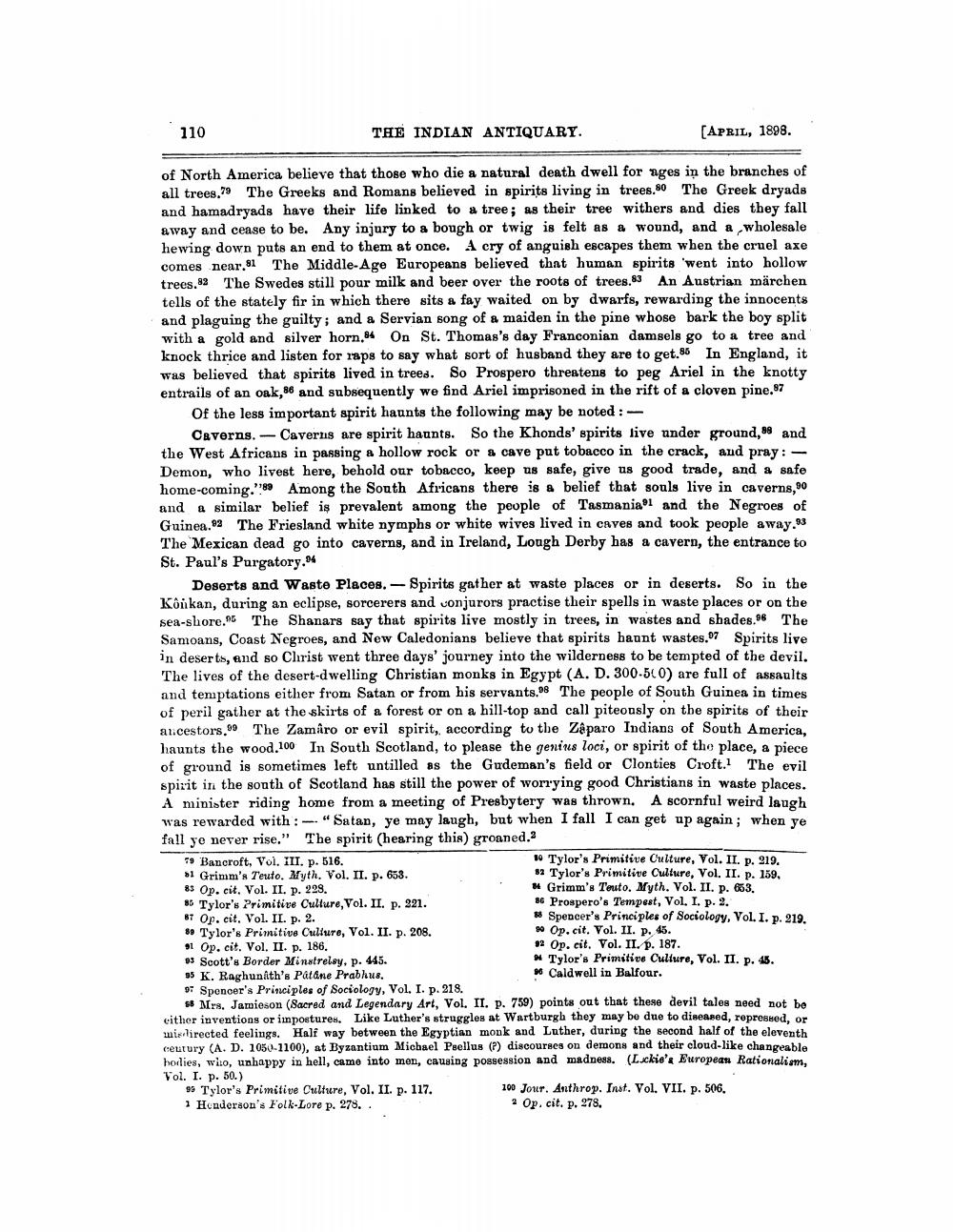________________
110
THE INDIAN ANTIQUARY.
[APRIL, 1898.
of North America believe that those who die a natural death dwell for ages in the branches of all trees.79 The Greeks and Romans believed in spirits living in trees. The Greek dryads and hamadryads have their life linked to a tree; as their tree withers and dies they fall away and cease to be. Any injury to a bough or twig is felt as a wound, and a wholesale hewing down puts an end to them at once. A cry of anguish escapes them when the cruel axe comes near.81 The Middle-Age Europeans believed that human spirits 'went into hollow trees.82 The Swedes still pour milk and beer over the roots of trees.83 An Austrian märchen tells of the stately fir in which there sits a fay waited on by dwarfs, rewarding the innocents and plaguing the guilty; and a Servian song of a maiden in the pine whose bark the boy split with a gold and silver horn. On St. Thomas's day Franconian damsels go to a tree and knock thrice and listen for 18ps to say what sort of husband they are to get.86 In England, it was believed that spirits lived in trees. So Prospero threatens to peg Ariel in the knotty entrails of an oak,86 and subsequently we find Ariel imprisoned in the rift of a cloven pine.87
Of the less important spirit haunts the following may be noted :
Caverns. - Caverns are spirit haunts. So the Khonds' spirits live under ground, and the West Africans in passing a hollow rock or a cave put tobacco in the crack, aud pray: - Demon, who livest here, behold our tobacco, keep us safe, give us good trade, and a safe home-coming.'89 Among the South Africans there is a belief that souls live in caverns, 90 and a similar belief is prevalent among the people of Tasmanial and the Negroes of Guinea.92 The Friesland white nymphs or white wives lived in caves and took people away.93 The Mexican dead go into caverns, and in Ireland, Lough Derby has a cavern, the entrance to St. Paul's Purgatory.4
Deserts and Waste Places. - Spirits gather at waste places or in deserts. So in the Konkan, during an eclipse, sorcerers and vonjurors practise their spells in waste places or on the sea-shore. The Shanars say that spirits live mostly in trees, in wastes and shades. The Samoans, Coast Negroes, and New Caledonians believe that spirits baunt wastes.07 Spirits live in deserts, and so Christ went three days' journey into the wilderness to be tempted of the devil. The lives of the desert-dwelling Christian monks in Egypt (A. D. 300-500) are full of assaults and temptations either from Satan or from his servants. The people of South Guinea in times of peril gather at the skirts of a forest or on a hill-top and call piteously on the spirits of their ancestors. The Zamiro or evil spirit, according to the Záparo Indians of South America, haunts the wood.100 In South Scotland, to please the genius loci, or spirit of the place, a piece of ground is sometimes left untilled as the Gudeman's field or Clonties Croft. The evil spirit in the south of Scotland has still the power of worrying good Christians in waste places. A minister riding home from a meeting of Presbytery was thrown. A scornful weird laugh was rewarded with: - "Satan, ye may laugh, but when I fall I can get up again; when ye fall yo never rise.” The spirit (hearing this) groaned. 59 Bancroft, Vol. III. p. 516.
10 Tylor's Primitive Culture, Vol. II. p. 219. ol Grimm's Teuto. Myth. Vol. II. p. 653.
92 Tylor's Primitive Culture, Vol. II. p. 159, 85 Op. cit. Vol. II. p. 229.
# Grimm's Teuto. Myth. Vol. II. P. 663. 86 Tylor's Primitive Culture, Vol. II. p. 321.
86 Prospero's Tempest, Vol. I. p. 2. 87 Op. cit. Vol. II. p. 2.
# Spencer's Principles of Sociology, Vol. I. p. 219. 89 Tylor's Primitive Culture, Vol. II. p. 208.
10 Op.cit. Vol. II. p. 45. 91 Op. cit. Vol. II. p. 186.
12 Op. cit. Vol. II. p. 187. 93 Scott's Border Minstrelsy, p. 445.
Tylor's Primitive Culture, Vol. II. p. 45. 95 K. Raghunath's Pátane Prabhus.
w Caldwell in Balfour. 97 Spencer's Principles of Sociology, Vol. I. p. 218.
55 Mrs. Jamieson (Sacred and Legendary Art, Vol. II. p. 759) points out that these devil tales need not be either inventions or impostures. Like Luther's struggles at Wartburgh they may be due to diseased, represeedor mislirected feelings. Half way between the Egyptian monk and Luther, during the second half of the eleventh century (A.D. 1050-1100), at Byzantium Michael Peellus (?) discourses on demons and their cloud-like changeable hoilies, wito, unhappy in hell, came into mon, causing possession and madness. (Lckie's European Rationalism, Vol. I. p. 50.) 95 Tylor's Primitive Culture, Vol. II. p. 117.
100 Jour. Anthrop. Inst. Vol. VII. p. 506. 1 Honderson's Foll-Lore p. 278..
? Op. cit. p. 278.




